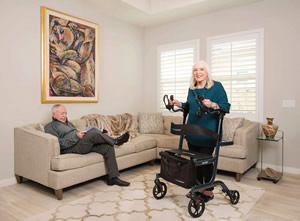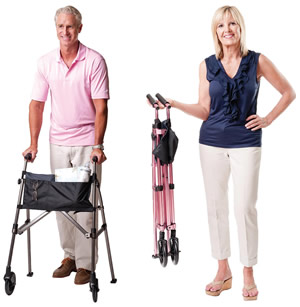Business Solutions
The Innovation Game
Why HME providers need to ensure that they serve up innovative, 'must-buy' products if they want to continue capturing the senior retail market.
- By David Kopf
- Oct 01, 2020

Photo © chones/depositphotos.com
Akey market segment that HME providers have served as one of
their cornerstone client demographics for literally decades is
seniors. That certainly makes sense given that during the better
days of CMS’s DMEPOS program, most providers derived 80
percent of their revenues (or more) from Medicare beneficiaries.
And, as the industry felt the business imperative to increasingly incorporate
retail sales into their revenue mix — with some providers going
completely retail — seniors have been along for the retail ride. But are HME
providers properly serving the senior retail market? Have they kept pace
with their customers? Do they need to reconsider the types of products that
they need to be offering those seniors?
CH-CH-CHANGES
For starters, seniors have seen some neglect from the HME space in the
past, because they were being served with basic products for the Medicare
reimbursement market. No wonder walkers, grab bars, and rollators of, say,
2010 looked so much like their predecessors from the 1990s (or earlier).
There was no imperative to improve, and the seniors were taking what
Medicare was giving them.
“The seniors of 20 years ago were from the Depression-era; were frugal
and not focused on spending money for themselves to improve their lives,”
says Craig Shugert, president and CEO of LifeWalker Mobility Products
(upwalker.com). “The seniors of today are wealthier, want to stay fit by
staying active and are willing to spend money on value-added products
which can improve their lives and help them to live longer, healthier lives.
“The surgeon general and CDC are focused on eliminating sedentary
lifestyles of our senior population,” Shugert adds. “Consumer products
companies should be focused on meeting this need.”
If a senior is purchasing the product directly, providers can’t be competitive
if all they offer are those commodity products.
“Say, seniors are coming in because have falls in their bathroom,” suggest
Troy Holland, president of Stander Inc. (stander.com). “If you walk them over
to a wall-mounted grab bar, they’ll say, ‘Really? Is there really not anything
more innovative or different than this?’ And that’s where you have the
opportunity to really show them something innovative, like our security pole
and curve grab bar that mounts anywhere in the room, in any part of the
home, and puts the grab bar right in front of them, right where they need it.”
Also, looks count for a lot. Seniors’ tastes in terms of product design have
changed. Products that enhance their life in terms of function also need to
reflect that in terms of form.
“I think seniors nowadays are looking for something that’s more sleek,
that’s more of a fashion statement, or innovations that they can show their
friends so that they tout their new walker, or rollator or whatever it is,” says
Troy Holland, president of Stander Inc. (stander.com). “It’s not the old, two-button
chrome folding walker with tennis balls that their grandma used, or
that their mom or dad used. They’ve got to get away from that and they
want to get away from that, right? They’re looking for innovation in every
aspect of their mobility and their life.”
This means providers need to think about product innovation when trying
to appeal to senior customers. They need to consider how they approach rounding out their “good, better, best” product
lineups for all their retail categories. Whether it’s
lift chairs, grab bars, rollators, or canes, design
and product innovation must be a consideration.
MOBILITY AIDS 2.0
Bearing that in mind, let’s consider a cornerstone
of senior medical equipment: walkers and
rollators. HME providers need to toss the industry
term “bent metal” into the wastebasket and start
thinking about how they can differentiate with
basic mobility aids. Both Stander’s Holland and
LifeWalker’s Shugert know this fact very well, as
their companies are dedicated to take these sorts
of products to the next level.

The UPWalker is an innovative take on the rollator
that lets users stand fully upright while using the
device. The design confers increased stability and
reduces back and wrist strain, which means users can
keep walking with it for longer.
In the case of LifeWalker, one of their premier
offerings is the UPWalker, an innovative take on
the rollator that lets users stand fully upright while
using the device, rather than leaning over it, which
is usually the case when using traditional walkers
and rollators. Two bars rise up on either side of the
user, and attached to them are two armrests with
handles and brake controls. Its development came
about after Shugert watched his family face the
Catch 22 of trying to stay active by using devices
that he felt were didn’t fully deliver.
“My parents and grandparents were advocates of
staying active as long as you can,” he recalls. “Using
mobility as medicine was their mantra as well as use
it or lose it! … When my 101-year-old grandmother
and mother-in-law started complaining about
avoiding active lifestyles because of the pain in
their wrists, back and joints while using their rollators
I started down the path of developing a better
mousetrap called the UPWalker to replace this 40-year-old, obsolete technology.”
Interestingly, that better mousetrap owes a bit to
race cars. By standing more inside the UPWalker,
users are safer than trailing behind the device.
“I am an engineer by education and learned
that, when center of gravity and downward forces
are moved inside contact points on the ground
(wheels), stability is created,” Shugert explains. “I
liken the concept to race cars which push wheels
outward and center of gravity inward between the
wheels. We needed to apply these engineering
concepts with forearm supports, which allows the
user to be supported more by shoulders rather
than pushing down on one’s wrists.”
This resulted in the UPWalker’s patented design
which, according to Shugert, is the only U.S.
company to meets the safety criteria of ISO 11199-3
for upright mobility both indoors and outdoors.
And that design has delivered on Shugert’s goal of
relieving the pain of using a walking aid.
“A clinical study now validated by a recent
survey found our series of UPWalker products
result in a more upright posture which provides
more efficient processing of oxygen, allowing
users to walk two to three times further (when
compared to their rollator/walker/cane), experience
less pain on the wrists, lower joints and
back,” he says. “Rather than looking down at the
ground while using a rollator use of the UPWalker
allows one to look ahead at eye level with friends,
improving dignity and self-esteem. It even helps
to improve one’s walking gait too.”
A year ago, LifeWalker refined the original
UPWalker to create the UPWalker Lite, which
Shugert says “has become a main staple at brick
and mortar retailers for the average senior, while
the original UPWalker is a more robust product
for heavy outdoor use and clinical applications.”
“We are now working on a new senior mobility
fitness device which not only encourages a
cardio workout by walking but provides an upper
body workout for the biceps, triceps, lateral and
pectoral muscles too,” he adds. “Look for this
product launch in December.”
Stander has been another innovative manufacturer
in the retail space, and that includes
its walkers and rollators as well. Knowing that
easy portability is something seniors need, the
company has a patented folding technology for its
EZ Fold-N-Go Walker and EZ Fold-N-Go Rollator.

The EZ Fold-N-Go Walker and EZ Fold-N-Go
Rollator solve a key problem with a lot of older
walker and rollator designs: they’re not very transportable,
even when they do fold. So Stander’s
engineers designed rollators and walkers that can
fold easily into a super-compact format.
“Our engineers saw one of the main challenges
that people have with a walker or rollator,”
Holland says. “And that is that they’re not really
portable. They’re big, they’re bulky, they’re hard
to get around. You can imagine grandma or
grandpa trying to put their rollator in the trunk of
the car and then walk to the front to get in the car.
That’s a nightmare.
So Stander’s engineers saw that a need for
something that can fold easily into a super-compact
format was needed.
“It folds up really compact and can go in the
front seat of the car with users,” Holland says.
“It can go in the overhead compartment of an
airplane, so they don’t have to wait at the jet
bridge for checking a walker or rollator. They can
just get it and go with them on their trip.
“We know that baby boomers are traveling, so
why not offer them something that makes traveling
much easier?” he adds. “And that’s really where our
folding technology comes in is allowing them to be
more free and more mobile.”
INNOVATIVE PROVIDERS
Regardless of what innovative products a
provider gets in their showroom, they must
innovate in terms of how they retail those items to
seniors. Shugert advises leveraging the investments
that their vendor partners have made in
developing and advancing those products.
“Our DME/HME and brick-and-mortar partners
display the product for consumers to use around
the store or take a walk outside,” Shugert explains.
“We spend many millions of dollars building
UPWalker’s brand awareness and product benefits
through TV and print advertising, driving consumers
to retail stores, which is working. We are even
working on cobranded commercial promotions
which drive consumers to specific retailers.”
And LifeWalker’s investing in backing the
product isn’t limited to advertising. The company
also provides a lot of in-store messaging materials
to help retailers communicate how UPWalker’s can
help seniors lead active lives.
“Our retailers will display a video of the
UPWalker showing aspirational outcomes of using
the UPWalker outdoors,” Shugert says. “We
provide a broad range of POP marketing materials
from product hang tags on every product shipped,
which shows the benefits of the UPWalker.
“We are even working on a health and fitness
program to encourage activity,” he adds “We have posters, literature, digital assets and other marketing collaterals to help
our customers achieve success. We also police to assure partners comply
with minimum advertised price.”
PRIME POSITION
Of course, many providers might be thinking, “Well, what about Amazon?
Innovations are great, but aren’t seniors just going to buy this stuff on Amazon?”
The TLDR is no, but the longer answer — the “why” — is that, while online
competition is a consideration, the HME provider has many advantages given
it’s established market position.
“We launched the UPWalker direct to consumer, which resulted in success,
but the number one question we received was ‘where can I go to try the
UPWalker?’” Shugert recalls. This led to LifeWalker working with the HME
providers who can work directly with seniors.
“Providers need to think, ‘how can I differentiate myself?’ because
they have all the tools to compete,” Holland says. “They can offer same
day installation. They offer customer service. They can offer warranties
and repairs. They can offer all of the things that seniors look for when we
purchase something from a retail location that we don’t get from purchasing
something online. They have the competitive edge and they’re going to be
able to be here for the long haul.”
Holland advises that providers look at their store as a retail sales center
and a retail sales floor, so that they can maximize those profit dollars by
selling best, better and basic options. That also means hiring the right salespeople
that can help seniors make informed decisions.
“Providers need people that know how to show customers features and
benefits, as well as the differences, and the advantages that they will lose if
they decide to go with a less expensive, less feature rich product,” he says.
“Salespeople that can also sell them on the higher quality, higher price,
definitely, but also higher-margin product that the store will make more
on. That’s how providers will thrive and be successful as retailers in this
changing landscape. And I think that that is where every DME/HME retailer
should be moving towards if they haven’t already.”
ANOTHER IMPERATIVE
Also, there’s another, more timely element to why providers need to really
need to rethink the senior retail: COVID-19. Seniors need HME providers’
help now more than ever. Besides wanting to continue living independent
and active lives, HME could be saving seniors’ lives.
“Aging in place, or aging at home in place, or aging in place at home —
whatever you want to call it — these baby boomers are looking at long-term
care facilities as a potential death sentence,” Holland explains. “We’re so
used to seeing our moms, and dads, and grandmas and grandpas going in
a long-term care facility, thinking ‘They’ll take care of them.’ Well, that’s not
going to be the case anymore.”
So senior clients are looking for product innovations that will help them
ensure that continuing to live in their homes remains a safe prospect.
“We have people that put eight of our security poles [which facilitates
standing, sitting and stability] in their house,” Holland says. “They put one in
every room, because it’s a grab bar right in front of them all the time, so they
can stand up from anything and they never have to worry about falling. It’s
that type of thing that I think is much different now.”
This article originally appeared in the Sep/Oct 2020 issue of HME Business.